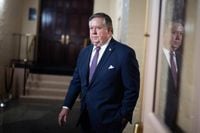California’s political landscape is bracing for a seismic shift as Governor Gavin Newsom pushes forward with an emergency redistricting plan designed to counter Republican-led efforts in Texas and other red states. The move, announced in a flurry of public statements and social media posts this week, is intended to offset what Newsom and his allies call an unprecedented, mid-decade gerrymander orchestrated by Texas Governor Greg Abbott and backed by President Donald Trump ahead of the 2026 midterm elections.
At the center of the storm is Republican Representative Ken Calvert, California’s longest-serving GOP congressman, whose Inland Empire district has become ground zero in the battle for control of the House. Calvert, who narrowly held onto his seat in 2024 against Democrat Will Rollins, now faces eight challengers and the looming threat that his district could be redrawn to favor Democratic candidates. The stakes are high: Newsom’s plan aims to flip at least five Republican-held seats in California, and Calvert’s is at the top of the list.
The origins of this showdown can be traced to Texas, where Governor Abbott, with Trump’s vocal support, is pushing a redistricting proposal that would eliminate five Democratic seats in Congress. According to CalMatters, the goal is to bolster the GOP’s House majority by skewing voting districts in Republicans’ favor. Newsom, incensed by what he views as a blatant power grab, has vowed to “fight fire with fire.” In a letter sent to Trump on August 11, Newsom wrote, “You are playing with fire, threatening to destabilize democracy, while knowing that California can neutralize any gains you hope to make.”
Unlike Texas, where the state legislature controls the redistricting process, California relies on an independent citizens’ commission. This bipartisan body, established by voters in 2008 and expanded in 2010 to include congressional districts, draws lines based on geography and communities of interest, rather than political advantage. Newsom’s plan would circumvent the commission by asking voters to approve new boundaries via a ballot measure in November 2025, with the new maps in place through 2030. To make that happen, the state legislature must authorize the ballot measure by August 22.
“Donald Trump called up Governor Abbott for one simple reason: to rig the 2026 elections,” Newsom declared in a statement, doubling down on his commitment to counteract GOP maneuvers. He has also hosted Texas lawmakers who fled their state in protest, further underlining the national implications of the redistricting fight.
Newsom’s approach has been anything but subtle. On August 12 and 13, he took to social media, mimicking Trump’s signature all-caps style: “DONALD ‘TACO’ TRUMP, AS MANY CALL HIM, ‘MISSED’ THE DEADLINE!!! CALIFORNIA WILL NOW DRAW NEW, MORE ‘BEAUTIFUL MAPS,’ THEY WILL BE HISTORIC AS THEY WILL END THE TRUMP PRESIDENCY (DEMS TAKE BACK THE HOUSE!).” He promised a “very important press conference this week with a major announcement,” stoking anticipation among Democrats and consternation among Republicans.
In his letter to Trump, Newsom described the GOP’s efforts as “an unprecedented, mid-decade hyper-partisan gerrymander to rig the upcoming midterm elections.” He added, “This attempt to rig congressional maps to hold onto power before a single vote is cast in the 2026 election is an affront to American democracy. This is not what the founders envisioned, and California cannot stand idly by as this power grab unfolds. I do not do this lightly, as I believe legislative district maps should be drawn by independent, citizen-led efforts, as we have done in California for the last two decades.”
The governor’s office, however, maintains that the legislature is handling the specifics of the new maps. “That is not something our office is actively involved in,” Brandon Richards, a spokesperson for Newsom, told CalMatters. Still, the governor’s high-profile role in the debate has made him the leading Democratic voice countering Texas Republicans’ efforts and has fueled speculation about his own ambitions, possibly for a 2028 presidential run.
On the other side, Rep. Ken Calvert has voiced strong opposition to Newsom’s proposal. “I strongly oppose the scheme being orchestrated behind closed doors by Sacramento politicians to take constitutionally afforded power away from the Independent Citizens Redistricting Commission and replace it with a process that would allow legislators to draw district maps that are gerrymandered to benefit themselves and their political allies,” Calvert said in a statement to CalMatters. “A partisan political gerrymander is not what the voters of California want as they clearly stated when they passed the VOTERS FIRST Act and participated in the Independent Citizens Redistricting Commission process.”
The 2021 redistricting already made Calvert’s district more competitive by adding the liberal Coachella Valley to traditionally conservative western Riverside County. In the 2024 election, Rollins ran a tightly contested campaign with an $8 million war chest, ultimately losing by just 3%. With the potential for even more Democrat-friendly boundaries and a crowded field of candidates—including business executives, an educator, and a pop star—the upcoming race is poised to attract national attention and a flood of campaign donations.
Meanwhile, the drama continues to unfold in Texas. Democrats there claimed victory this week after stalling a special session called to advance the GOP’s redistricting plans. According to ABC News, Texas Democrats said they “have killed this corrupt special session on behalf of Texas families, exactly what we said we’d do when we left the state.” But the battle is far from over. Governor Abbott has vowed to call a new special session immediately, keeping redistricting on the agenda.
Newsom’s critics argue that his plan undermines the very principles of fair, citizen-led redistricting that California voters enshrined in law. Supporters counter that extraordinary times call for extraordinary measures, especially when the integrity of national elections is perceived to be at stake. As the deadline for legislative action approaches, all eyes remain on Sacramento—and on the broader tug-of-war between the two nation’s most populous states.
The outcome of this high-stakes confrontation will reverberate far beyond California and Texas, shaping the balance of power in Washington and setting a precedent for how states respond to partisan redistricting in an era of deep political polarization.






